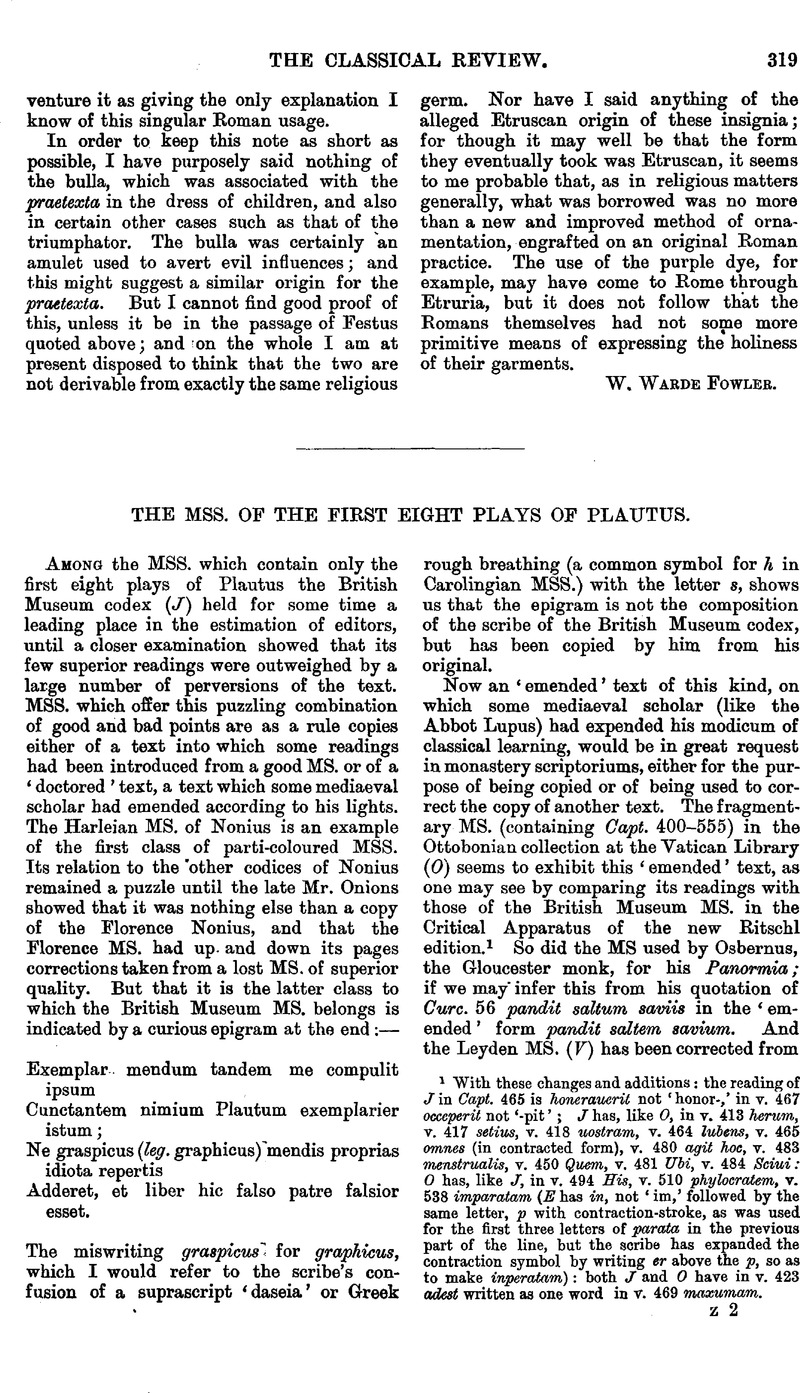No CrossRef data available.
Article contents
The MSS. of the First Eight Plays of Plautus
Published online by Cambridge University Press: 27 October 2009
Abstract

Information
- Type
- Review Article
- Information
- Copyright
- Copyright © The Classical Association 1896
References
page 319 note 1 With these changes and additions: the reading of J in Capt. 465 is honerauerit not ‘honor,’ in v. 467 occcperit not ‘-pit’; J has, like 0, in v. 413 herum, v. 417 setius, v. 418 uostram, v. 464 lubens, v. 465 omnes (in contracted form), v. 480 agit hoc, v. 483 menstrualis, v. 450 Quem, v. 481 Ubi, v. 484 Sciui: 0 has, like J, in v. 494 His, v. 510 phylocratem, v. 538 imparatam (E has in, not ‘im,’ followed hy the same letter, p with contraction-stroke, as was used for the first three letters of parata in the previous part of the line, but the scribe has expanded the contraction symbol by writing er above the p, so as to make inperatam): both J and 0 have in v. 423 adest written as one word in v. 469 maxumam.
page 320 note 1 Through the kindness of the Leyden Librarian the MS. was deposited for a time at the Bodleian Library.
page 320 note 2 I venture to differ from Prof. Schoell in regard to the Leyden reading in Aul 234. It seems to me that memordicus of V1 has had an apex put over thee by Va. This is a common practice of the V2-eorrector when he wishes to indicate that a long monosyllable like me, te, se, is to be read as a separate word, apart from the longer word with which the scribe has joined it (cf. Capt 692 tuasté V1, tuaste V2; 675 credité V1, credite V2. These are to be understood as icorrections to tuas te, eredi te) A recent corrector has added two strokes above the u, that is to say, has changed mordicas into mordiciis It is true that this recent corrector sometimes retraces with his black ink the light brown ink-strokes of the v 2-corrector (e.g the s of res in Aul 544 seems to be supraseript by V2 and rewritten by the recent corrector), but he has not in my judgment done so in this case. These strokes above the letters of memordicus have thus no signification that the order should be transposed to mordicus me In Aul 401 sq it should be noticed that the addition tu istum … mihi is by V2. I do not know whether the following points are worth mention: Capt 1 c marg. (i.e c[aptus]) V2; 9 profugiens V1, fugiens V2 (V1 has put a dot under each of the three letters pro-); 98 hue V1, hunc V2; 110 a marg. (i.e a[duorte])v2; 297 scio v1, scito "v2; 337 redimator v1, -tur v2; 385 Philocrates PHI. ut v1, del PHI. v2; 432 fidem v1, fide v2; 538 imperatam; 577 gnatum v1, natum v2; 605 credius ut vid (whether this or creduis was the reading of EI could not decide when I examined the MS. last January); 648 cicinnatus; 659 i marg v2; 780 cybum; 792 sese v2ex sere ut vid.; 795 in hac platea, 1 ex a; 812 fecidos (t v1ut vid.); Aul 807 anueram v1, an uera v2. They are for the most part corrections of obvious misprints in Prof. Schoell s collation or relate to minor points of spelling. But one of them, the note on Capt 9, gives additional evidence of the connexion of these light ink corrections in the Leyden MS. with the ‘ emended’ text of the first eight plays. I take it that fugiens for profugiens in v. 9 was a mere clerical error in the ‘emended’ copy, like inde inde in v. 490. In Aul 659 Vs reads Mi sotio tuo, as J reads illi socio tuo.

